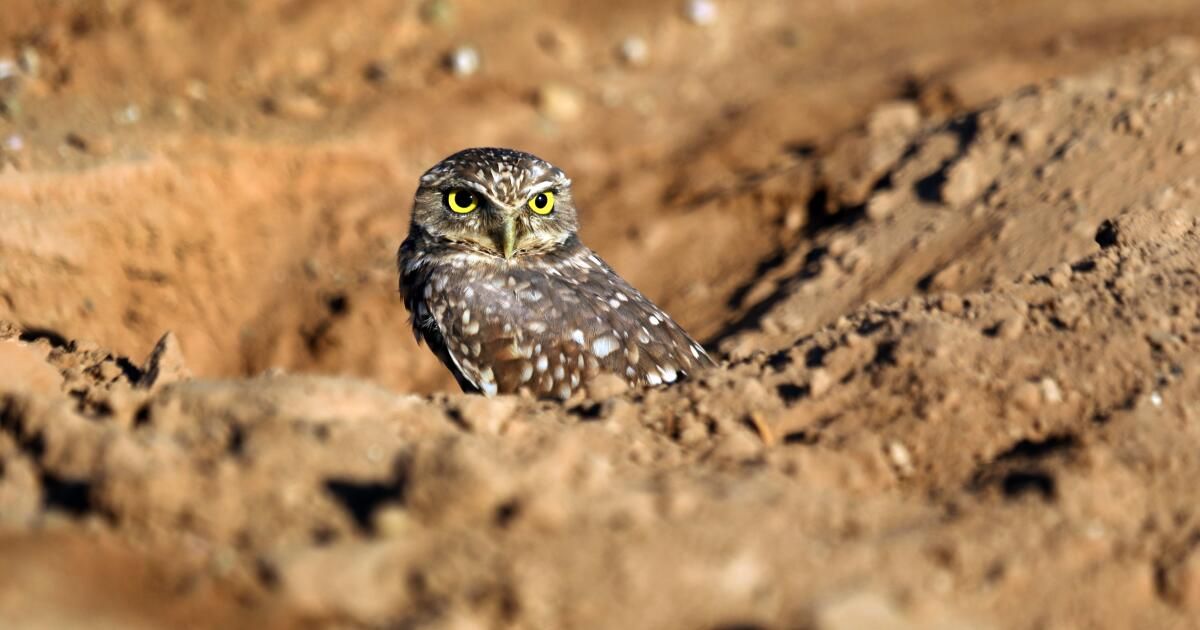Western burrowing owls are tiny, adorable and silly, and conservation organizations have renewed calls for the state to protect them before it's too late.
Now, more than 20 years after a formal request was made, California wildlife officials appear to be listening.
The California Department of Fish and Wildlife this week recommended that state wildlife policymakers consider a petition to list the owls as endangered or threatened.
Aggressive and shocking reports on climate change, the environment, health and science.
It's the first of several steps native underground nests must take to gain protection under the state's Endangered Species Act. That doesn't mean it's justified, but it could be.
While the species' fate is by no means decided, groups pushing for the designation are hopeful. This petition, filed in March, has already achieved greater reach than one filed just over 20 years ago.
“We’re in a bit of an emergency situation,” said Jeff Miller, a leading conservation advocate at the Center for Biological Diversity, which drafted both petitions. “It would be a little shocking if they didn’t get some kind of protection.”
So what changed?
Conservationists say the situation is even more dire for the owl. It was once one of the state’s most common birds, present “virtually everywhere” where there was open, low-elevation grassland, Miller said.
But “the population is very low,” Miller said. As a breeding species, it is “difficult, if not impossible, to recover once it is lost from a specific locality.”
Around the San Francisco Bay Area, there are about 25 breeding pairs, down from the roughly 1,000 pairs in the region's South Bay area alone about 30 years ago, he said.
Miller describes the owls as “eggs on legs” because their round head and body rest on long, spindly legs. They stand just 10 inches tall, have bright yellow eyes and, as their name suggests, live underground. “They can look a little silly,” Miller said.

“A bit silly,” really.
(Lauren Bettino)
Nonsense aside, conservationists say, incorrect assumptions about owl behavior have been corrected and the political winds have shifted, fueling hope that this petition has a chance.
Habitat loss remains a major concern. Real estate developers often consider owl habitat when building condominiums and golf courses.
Development and sprawl efforts targeting ground squirrels, whose burrows are appropriated by owls, have driven the animals from the grasslands they inhabit. Renewable energy projects and, in some cases, agriculture have also encroached on their burrows.
Pamela Flick, California program director for Defenders of Wildlife, one of the applicants, said the best available science shows the owls are gone or near extinction in nearly 30 percent of their range in the state, calling that “really concerning.” Other applicants include the Burrowing Owl Preservation Society, the Urban Bird Foundation, the Central Valley Bird Club and the San Bernardino Valley and Santa Clara Valley Audubon Societies.
When the first petition was filed in 2003, it was argued that owls in population strongholds like the Imperial Valley could simply fly to other parts of the state and boost dwindling populations.
That turned out to be wrong. Miller said decades of banding and tracking owls have shown that they typically do not settle and breed elsewhere if they are driven out of an area.
Two key players in the petition's future are the state Fish and Game Commission and the California Department of Wildlife. The department implements and enforces the rules developed by the commission, and also conducts research to inform the commission's decisions.
Miller said it was a “very different political climate” when his group and others filed the first petition.
Earlier this year, he told The Times that the commission was initially run with hunting and fishing as its top priority. Now, he said, there is a greater emphasis on conserving vulnerable species.
Miller said there's another twist to the issue: Rather than pushing for statewide protection, the petitioners are focusing on the most endangered owl populations. Conservationists are seeking endangered species status for owls in the Bay Area, as well as in central-western and southwestern California. They're seeking threatened species status for owls in the Central Valley and the southern desert.
Dividing ranges could also mitigate pushback. Some of the areas where owls are doing best, such as the Imperial Valley and southern Central Valley, are on engineered agricultural lands. “We don’t want to be at odds with an economic interest if we don’t have to,” Miller said.
Ultimately, the decision would be up to the Fish and Game Commission, which could choose to list certain populations, or none at all, or do so at the state level. The birds are not listed under the federal Endangered Species Act.
Conservation groups expect the commission to vote on whether to accept the petition on Oct. 10. If it does, the owls will become a “candidate” species, granting them the same protections as if they were listed under the state’s Endangered Species Act while a 12- to 18-month status review proceeds.












